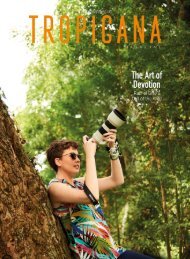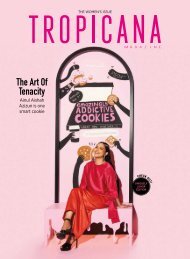You also want an ePaper? Increase the reach of your titles
YUMPU automatically turns print PDFs into web optimized ePapers that Google loves.
THE GAME CHANGER<br />
“When Datuk Ramli first<br />
arrived in Bhubaneswar<br />
in 1976, it was a bare<br />
and dusty city, a wild<br />
contrast to Europe<br />
where he had just<br />
finished a ballet tour<br />
with the Sydney Dance<br />
Company.”<br />
Odissi is the oldest surviving dance form<br />
in India, and a distant precursor to today’s<br />
Odissi was practised in the shrines by female<br />
temple dancers called mahari or devadasi.<br />
The ceremonial aspect <strong>of</strong> the dance was lost<br />
during the state’s turbulent history with<br />
successive foreign rulers and was replaced<br />
by the gotipua, a traditional dance <strong>of</strong> Odissi<br />
elements and acrobatics performed by<br />
young boys dressed up as girls. This style <strong>of</strong><br />
dancing would have a heavy influence on<br />
what is practised today.<br />
Datuk Ramli’s journey with Odissi<br />
started in Australia in the 1970s. Whilst<br />
studying for his engineering degree and<br />
pursuing a career in ballet, he fell in with<br />
fellow Malaysian student, Zamin Haroon<br />
(who would later become celebrated Indian classical dancer, Chandrabhanu).<br />
One afternoon, while hanging out at Zamin’s home and listening to records,<br />
Datuk Ramli heard his first Odissi song, a track by renowned vocalist<br />
Raghunath Panigrahi, and he was hooked. “ I fell in love with the music first<br />
and it triggered my interest in Odissi,” he says. As a perfectionist, it was<br />
inevitable then that the young Ramli Ibrahim would make his way to Orissa<br />
to learn from the gurus.<br />
“ I met with the great dancer Indrani Rahman who told me that if I was<br />
learning Odissi, I must meet with Debaprasad Das,” remembers Datuk Ramli.<br />
Debaprasad Das is one <strong>of</strong> the pioneering Odissi gurus in India, known for his<br />
naturalistic style. “ Eventually I met with him in Bhubaneswar. When I saw his<br />
then-student Gajendra Panda performing, I knew that this was the style that<br />
I wanted. I took to Debaprasad and started learning from him,” relates Datuk<br />
Ramli as we settle in for our interview at the spartan reception area <strong>of</strong> the<br />
Odisha State Guest House, where he has a suite.<br />
When Datuk Ramli first arrived in Bhubaneswar in 1976, it was a bare and<br />
dusty city, a wild contrast to Europe where he had just finished a ballet tour<br />
with the Sydney Dance Company. But he was unfazed. “ There was no culture<br />
shock,” he insists. “ I love the chaos and flexibility <strong>of</strong> life.”<br />
By now he is comfortable in this city that he regards as a second home,<br />
constantly pointing out landmarks as we travelled around Bhubaneswar. “ The<br />
city has changed a lot since then. One <strong>of</strong> the differences I’ve seen is that the<br />
city has gone through a greening campaign. It wasn’t so green before. There’s<br />
been a great improvement in town planning here and it’s on the cusp <strong>of</strong> being<br />
a Smart City,” he says.<br />
In 1982, Datuk Ramli returned to Kuala Lumpur and embarked on a<br />
stratospheric career as an Odissi dancer and choreographer. A part <strong>of</strong> the<br />
dynamic 1980s arts scene in Kuala Lumpur, Datuk Ramli was certainly a<br />
force to be reckoned with, introducing a little-known Indian classical dance<br />
to Malaysian audiences and single-handedly nurturing it to become a part<br />
that is well entrenched within the local Malaysian dance industry today.<br />
In 1983, he formed Sutra Dance Theatre, followed by the Sutra Foundation<br />
in 2007, under which umbrella he now operates the dance company, an<br />
academy and an art gallery.<br />
TM | MARCH/APRIL <strong>2018</strong><br />
108
















